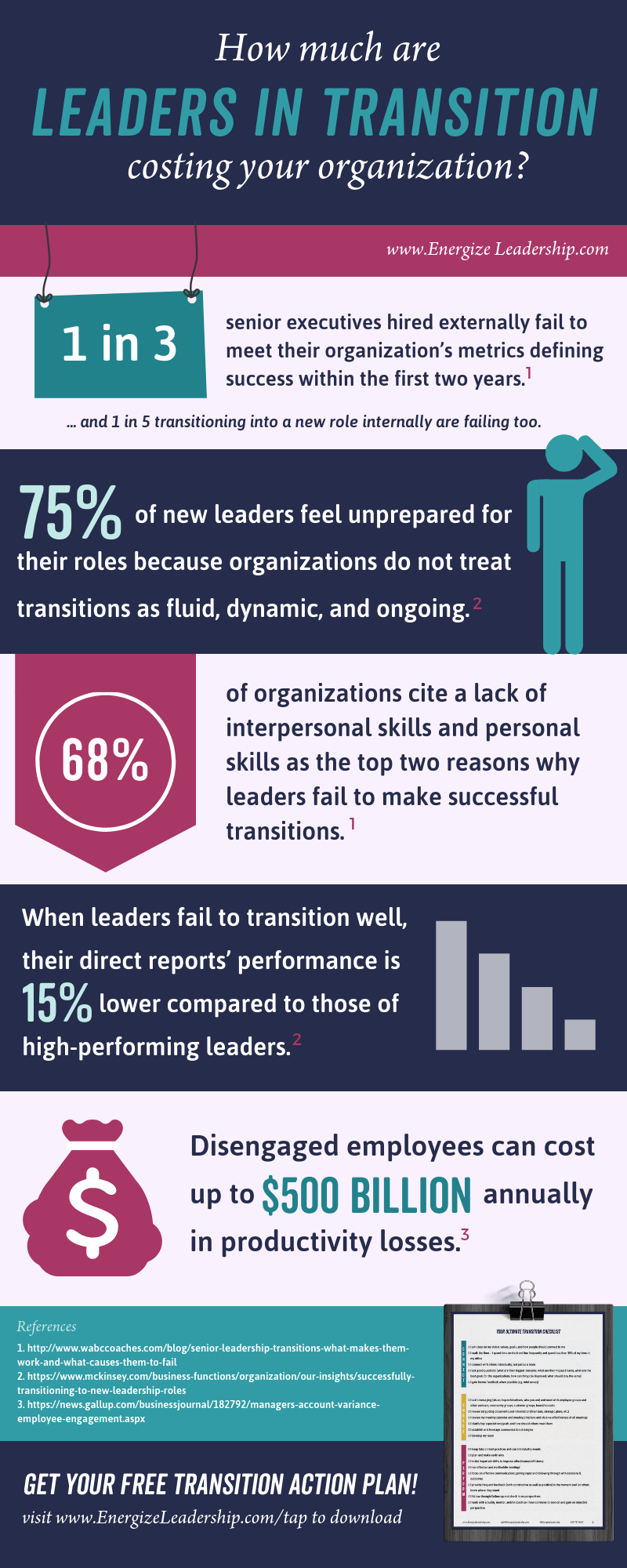Why Your Newly-Hired Leaders Are Hurting Your Bottom-line (and How to Fix It)
One of the more consistent challenges our clients face these days is the volume of transitions occurring at leadership levels. With availability of talent at an all-time low, the burden to the organization is significant and seemingly unending.
Often left spinning, a team struggles while lacking a leader only to sit in adjustment mode for a year or more after a replacement is eventually found. Even when an internal placement is made, leaders entering a new role are often overwhelmed with their new duties, and sometimes in living up to their predecessor’s esteemed reputation. The pitfalls a new leader faces are endless and the chance of success is dependant on so many variables.
The bottom line:
Transitions can prove to be an extremely tough time–and in the face of today’s fast-paced and ever-changing work environment–they are more critical than ever to get right.
Statistics1 show one in three senior executives hired externally fail to meet their organization’s metrics defining success within the first two years, and one in five transitioning into a new role internally are failing too. These numbers are staggering and in order to address the reasons why failure is so common, we must first explore what some of those reasons are:
- Cultural fit. One challenge cited by 79% of leaders hired externally and 69% hired from within is that navigating new people and new political currents appears to be particularly hard2. The culture of an organization requires some much needed acclimation by anyone joining from the outside, but the differences in subculture across various workgroups within the same organization can prove equally taxing to those transitioning internally.
- Organizational support. Studies show that 75% of new leaders feel unprepared for their roles because organizations do not treat transitions as fluid, dynamic, and ongoing3. Therefore, there is an inherent lack of attention toward infrastructure and processes required to support the needs of leaders taking on new roles. In fact, it appears that just 27.8% of American leaders feel their organizations are doing the right things to prepare leaders for future positions4.
- Personal challenges. Leaders often also have to make adjustments of their own, the top three most difficult, found in a survey4 conducted by Development Dimensions International in conjunction with World Business Magazine, include: 1) navigating organizational politics, 2) dealing with ambiguity or uncertainty, and 3) making the shift to getting work done through others. These challenges notably all involve people, whereas challenges ranked lower on level of difficulty to deal were all things leaders could accomplish by themselves (e.g. “thinking strategically,” “giving up my reputation as an expert,” and “learning to lead across borders”).
- Skills. Interestingly, 68% of organizations cite a lack of interpersonal skills and personal skills as the top two reasons why leaders fail to make successful transitions5, which seems to coincide well with the fact that leaders cited people-related challenges as being the hurdle most difficult for them to overcome.
Why does any of this matter, you ask?
A slew of very important reasons. For starters, addressing these gaps is absolutely critical if organizations want their teams to meet performance goals: a McKinsey6 study finds that nine out of ten teams whose leader had a successful transition go on to meet their three-year performance goals. This study also found that the risk of attrition for these teams is 13% lower, and what’s more, it affects the bottom-line: these teams were also found to generate 5% more revenue and profit than average!
On the flip side, the consequences of not addressing these gaps can be dire. For instance, when leaders fail to transition well, their direct reports’ performance is 15% lower compared to those of high-performing leaders. They are also 20% more likely to become disengaged, disillusioned, or quit. In addition, the direct losses in expense associated with advertising, searches, recruiting, onboarding, relocations, sign-on bonuses and so on–not to mention the time and personnel involved with all of these processes–are not easily regained when leaders consistently fail in their transitions.
Lastly, and quite arguably the most significant consequence of a failed transition, leaders don’t just fail themselves, they fail their employees. And losing the trust of your employees can be one of the most difficult repercussions to reverse, and potentially also the greatest hit to your bottom-line: as one 2015 Gallup study (The State of the American Manager7) found, disengaged employees can cost up to $500 billion annually in productivity losses.
So what can leaders do to maximize the chances that they successfully manage the complexities of transitioning into a new role?
Setting New Intentions
As far as creating a new culture while honoring the past, it is important for any new leader to take careful stock of what matters to the team, what was working well, as well as what wasn’t, and clarify what they want to keep in order to feel engaged and be most productive. Little by little, adding new expectations and establishing new “norms” is a sure way to set the long-term transition up for success.
Organizational Support
The onus is on organizations to set up the structures, processes, and the tone to continually meet the needs of every leader going through a transitionary period. This can include 1) fostering an environment where peers, superiors, and other colleagues take an active role in serving as a support network, providing guidance and feedback along the way; or 2) a combination of leadership coaching and customized transition plans (which have been shown to double the likelihood of success, yet only 32% of organization use them!!8).
—
The reality is, establishing a supportive framework for transitioning leaders takes time and resources. Leadership is what makes or breaks an organization which leaves little room for argument against making a commitment to ensure success. Energize Leadership is here to help offload the time and hefty price tag of developing in-house programs. Take a look at the Leader Success Kit, which is designed to support leaders who are transitioning into a new role by equipping them with a plan, a strategy, and the critical support they need for at least the first 90 days in their new role.
Your efforts to support your leaders in getting access to the right resources, expertise, and leadership development tools is so crucial to their success during this time. Imagine if they all were successful…

References:
- Senior Leadership Transitions: What Makes Them Work and What Causes Them to Fail? by Patricia Wheeler, PhD/
- Successfully transitioning to new leadership roles By Scott Keller and Mary Meaney
- 50 Percent of Leadership Transitions Fail. This Simple Plan Can Save You Millions by Adam Robinson Co-founder and CEO, Hireology
- Leaders in Transition: Stepping Up, Not off by Matt Paese, Ph.D., and Richard S. Wellins, Ph.D
- Senior Leadership Transitions: What Makes Them Work and What Causes Them to Fail? by Patricia Wheeler, PhD
- Successfully transitioning to new leadership roles By Scott Keller and Mary Meaney
- Managers Account for 70% of Variance in Employee Engagement by Randall Beck and Jim Harter
- Patricia Wheeler, “Executive transitions market study summary report: 2008,” The Institute of Executive Development, 2008; “Ascending to the C-suite,” April 2015.




